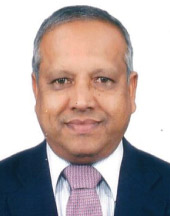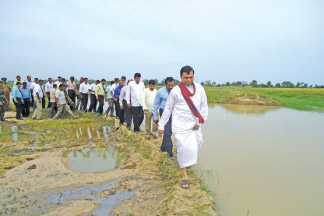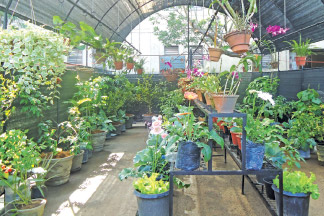Poly-net houses to avert crop destruction
By L.S. Ananda WEDAARACHCHI
|

NEAIP Director S.K. Liyanage
|
Advanced 'Scientific systems' have been formulated by developed
countries to save harvests and cultivations from natural disasters such
as floods, heavy rains and drought. Those methods have been introduced
to Sri Lanka for better productivity, said North East Agriculture and
Irrigation Project (NEAIP) Director S.K. Liyanage in an interview with
the Sunday Observer.
Excepts of the interview:
Q: The people who visited the Vavuniya Agriculture Exhibition
2011, were impressed by the two Poly Tunnel Cum Net Houses for
vegetables, fruits and plants. Another Poly net house has also been
built in the Parliamentary Premises. Is there a plan to popularise these
poly-net houses?
A: These are samples of a project which will be implemented
islandwide soon. There are no stable prices for vegetables, fruits or
food items such as onion, and potatotoes in Sri Lanka while cultivations
and harvests are being destroyed by natural disasters and as a result
prices escalate. When cultivations are successful, prices drop. On the
other hand, prices are stable in advance countries throughout the year
due to the application of scientific methods in Agriculture
Q: Sri Lanka is blessed with natural resources. Ancient
farmers wisely used rain water for cultivation by constructing tanks
such as Tissaweva, Yodhaweva.
|

Minister Basil Rajapaksa leading a team offficials on an
inspection tour inspecting a dam |
The Yala-Maha cultivation seasons are also based on natural climatic
condition. In this context do we need poly-net houses?
A: The ideal example for the need of poly-net houses for
cultivation was last January, February, due to islandwide heavy rains
and floods. One third of the paddy harvest was destroyed and the total
vegetable cultivation was affected. Sri Lanka did not face a severe food
shortage or food crisis due to January-February floods owing to the
timely steps taken by the government specially the Ministries of
Agriculture and Economic Development.
The crash programs for paddy and vegetables and other food
cultivation launched in Matale, Nuwara Eliya and Kandy Districts were
successful. During the New year season there was a surprise drop of
vegetable prices due to over supply of food items and vegetables to the
market.
The government provided seeds and fertiliser free of charge to
encourage farmers to recultivate their lands. Millions of rupees were
spent by the government on a crash program. If we have a poly-net house
scheme, floods or rains will not affect cultivations and smooth supplies
to the market will be ensured.
Poly-Tunnel cum nethouses for agriculture are being used by advanced
countries such as Germany, the Netherlands, Japan and Israel. Infact
their cultivation is safe even during winter due to the scientific
methods which they adopt for agriculture.
Q: What is the further plan to expand the poly-nethouse
scheme?
|

A Poly-net house |
A: The target of the poly-net house program is to set up
14,032 poly-net houses having at least one net house in a Grama Niladari
Division which will help farmers as well as the commercial agriculturers
to familiarise the value of Net houses. This project is being handled by
the Economic Development Ministry.
Q: Is there any link between Divinaguma and Gami Diriya
Economic Development projects-launched by the government at grass roots
level?
A: The DiviNaguma program launched by Economic Development
Minister, Basil Rajapaksa is bringing successful results. It was to set
up over one million home gardens.
The Economic Development Minister had given a farsighted approach to
grass roots level livelihood development projects which are being funded
by the World Bank and other Donor Agencies. The Minister-very correctly
pointed out that the root of the problems should be addressed without
touching the surface. Under the "Reawakening Sri Lanka program", the
World Bank had agreed to provide funds upto 2014 for livelihood
Development projects aiming at sustainability in the villages in the
districts in the Northern and the Eastern Provinces Sustainable
livelihood programs were mainly limited to provide basic requirements
such as seed, plant materials, chicks and cows for Agriculture and small
scale livestock projects at village level. It was later realised that
these schemes are not capable of bringing sustainability to villagers in
the long run.
Q: Can you explain the present approach to eradicate poverty
and develop the rural sector in Sri Lanka?
A: "Gamidiriya" is a project which aims at sustainability at
village level. At the beginning this program was limited to livelihood
development such as self-employment and small-scale projects. Under the
instructions of Minister Basil Rajapaksa, the "Gamidiriya" program was
revamped.
Further under the agreement signed by Sri Lanka and the World Bank on
"Reawakening Sri Lanka" funding facilities were limited only to 12
districts in the North, the East and the North Central provinces. Flood
devastation in January and February in 2011 has heavily damaged Kandy,
Nuwara Eliya, Matale, Ampara and Badulla districts. The dams of the
ancient tanks were breached or threatened by floods. In fact it was
evident that a "Dam safety program" was also an urgent need.
Minister Basil Rajapaksa has convinced the World Bank about the
prevailing situation and "Donor Agencies". As a result, financial
assistance was granted to other districts.
At present sixteen districts are being covered by the Gamidiriya
Development Foundation. Basic infrastructure facilities in villages such
as roads, tanks are also being constructed or are being renovated. |

